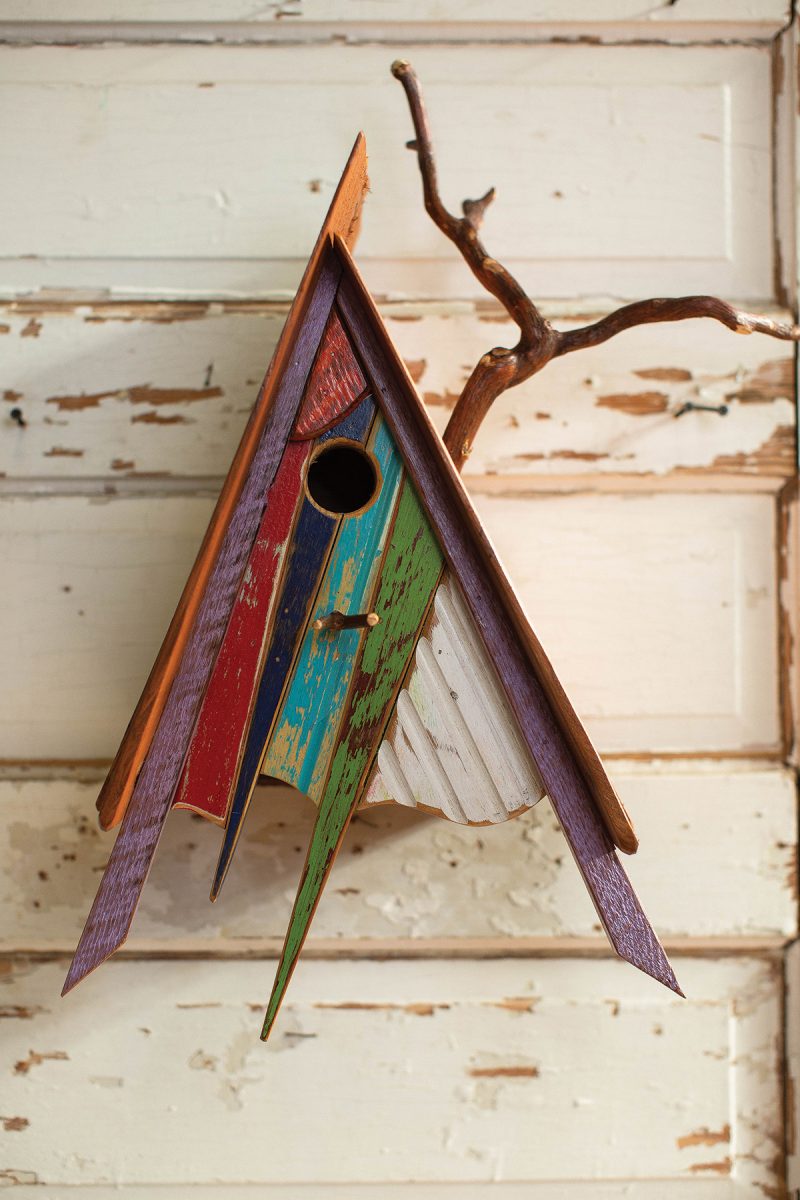Woodworker’s retro-modern birdhouses are relentlessly in demand

Photo by Colby Rabon
Ken Wheeler was doing a cabinet job, crafting the project with rare wormy chestnut. This was 25 years ago, before using salvaged material became common, and the woodworker, based in Saluda, was ahead of his time. He recalls that he “didn’t want to burn or throw away any of that wood — so I made a birdhouse out of the scraps and leftovers.”
Since then, he’s made at least 4,000 of them. He averages about 200 birdhouses per year.
Wheeler was introduced to woodworking by his father and took some woodworking classes in college, but most of what he knows was learned on his own, through hands-on experimentation. If experience was calculated in wood shavings, his would fill a silo, because he’s been designing cutting, trimming, nailing, gluing, and polishing wood for 40 years.

Photo by Colby Rabon
He taught himself how to split wooden shingles by hand, the way early settlers did to make roofing and siding materials. “I was going to cover the side of my shop with them, but didn’t get around to it, so I had 3- or 4,000 thousand shingles just laying there. I began using them on my birdhouses, and used them all up in the first 10 or 11 years.”
And while Wheeler is an extraordinary prolific birdhouse maker, it’s a sideline that has only accounted for about a third of his wood shop’s output. But since he’s always making furniture — and in the process making wood scraps — he’s always got the makings of his next birdhouse. “If you saw my shop, you’d be aghast. I don’t throw away anything. There is all this stuff laying around on the floor and it just keeps getting smaller and smaller, until it ends up in birdhouses.”
Wheeler’s birdhouse sales really took off when he started adding color — a distinction that separates his style from virtually all others in the marketplace. “I was making them out of barnwood and had a piece off of a door casing that was yellow,” he recalls. “When I put it on the birdhouse, the color just popped, and after that, I purposely added some color to each one.”

Photo by Colby Rabon
Wholesalers, galleries, and customers flocked to these unusual birdhouses that featured shades of natural wood mixed with hues like electric lime, autumnal grape, safety orange, retro pink, and swimming-pool blue. One might even say they began flying off the shelves.
The houses’ architecture, though, is more modern than quaint. Wheeler cuts sharp, angled pieces for the faces that mimic bird wings, and likes to use wood that’s been painted and repainted in layers, to add color and character. But the aerodynamic little buildings are perfectly functional, and customers sometimes send Wheeler videos of the birds who take up residence.
He also designs them so the bottom of each birdhouse can be easily removed for cleaning. “I have some that have been outside so long they have moss and lichen growing on the roof,” he reports. “But the birds still use them. Who knows? Maybe they even like them better that way.”

Photo by Colby Rabon
For reasons Wheeler can’t explain, Eastern Bluebirds are particularly fond of his houses.
Meanwhile, the demand from humans has always been unrelenting. What surprised Wheeler the most was when people starting collecting his birdhouses in their own human houses. “At first, the ones I made were a little crude, but they evolved to look more like pieces of art. I bet half the people who buy them now don’t ever put them outside; they buy them to decorate their homes.”
They’re also the perfect wall art to accompany Wheeler’s handcrafted furniture, most of it also made from reclaimed wood. Pieces include stools, tables, beautiful high-backed rocking chairs, and funky, odd-shaped cabinets.

Photo by Colby Rabon
But not all of his work is functional. For his quirky figurative wall sculptures, Wheeler will “find an interesting body form” and add in vintage ephemera such as an old pressure gauge or a kerosene lantern to suggest a head.
“I collect old crystal, brass, and silver doorknobs and put the knobs on the arms, or use them as an extension of the decorative legs,” explains Wheeler.
When the figures are finished, he calls them “fallen angels.”
Ken Wheeler, Saluda. Wheeler’s birdhouses and other creations are sold at Gallery of the Mountains, part of the Historic Grovewood complex at Asheville’s Omni Grove Park Inn (grovewood.com/gallery-of-the-mountains); at Screen Door (115 Fairview Road, Asheville, 828-277-3667); at Flow Gallery (14 Main St., Marshall, flowmarshall.com); and at Seven Sisters Gallery (119 Broadway Ave., Black Mountain, sevensistersgallery.com).
